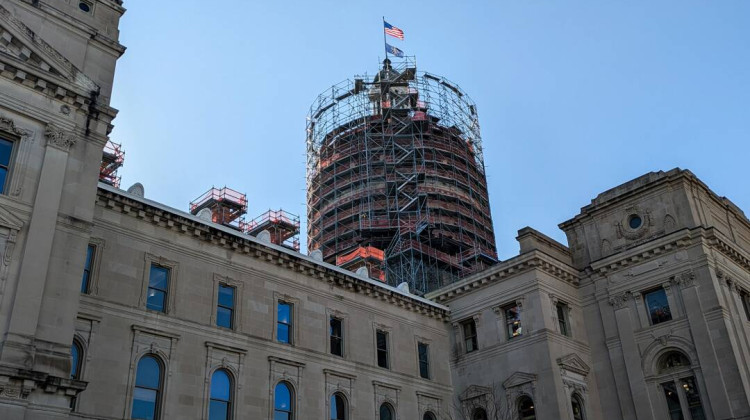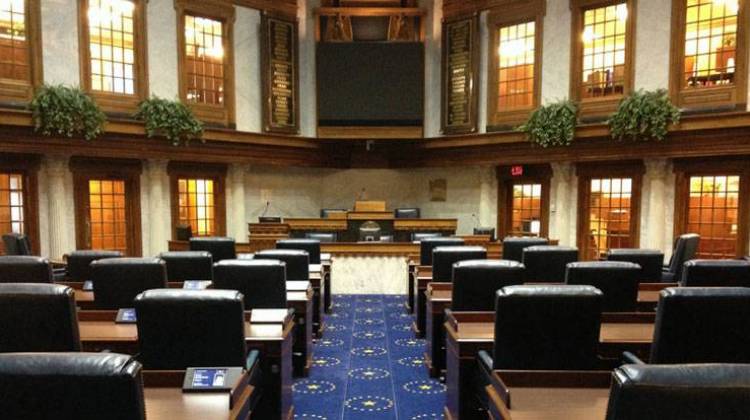
Retailers, worried that shoppers are cutting back their holiday spending this year, are hiring fewer seasonal workers. Shown is the Flatirons Crossing mall on Nov. 26, 2021 in Broomfield, Colorado.
Photo by Michael Ciaglo/Getty ImagesCasey Quinlan, Indiana Capital Chronicle
Black Friday shoppers may notice longer lines and fewer retail associates in some of their favorite stores than in past holiday seasons as retailers scale back seasonal hiring over concerns about consumer spending.
JCPenney is hiring 12,000 fewer workers than last year. Macy’s 3,000 fewer. Meanwhile a Walmart executive said the retail giant has been hiring “throughout the year” and plans to serve customers with the workers it has. And Challenger, Gray, and Christmas, which tracks employment trends, reported that so far, this year has had the fewest announcements of large-scale seasonal hiring plans since 2013.
“Hiring is a really good indication of retailers’ sentiment of the expectation of holiday (sales) and when they’re kind of ho-hum about increasing the numbers, that really does demonstrate their number one concern for less than gangbuster sales,” said Marshal Cohen, chief industry analyst at the NPD Group, a market research company.
The careful approach to hiring reflects the mixed messages in the economy. The labor market has remained resilient with an unemployment rate below 4% for the 21st straight month, inflation has fallen and wages have risen. Since 2021, inflation-adjusted consumer spending on retail goods has remained fairly high. But the personal savings rate has fallen since May and credit card delinquency rates are up.
Economists, as well as retailers, have signaled that they are worried about the effects of the return of student loan payments on the health of the economy, since consumer spending represents so much of the U.S.’s economic activity. The Fed’s long campaign to raise interest rates, although paused at the moment, has also affected consumers.
Adrian Mitchell, chief operating officer and chief financial officer at Macy’s Inc., said in the second quarter earnings call in August that Macy’s is thinking about “consumers’ ability to pay debt using their disposable income.”
“This is about credit card balances, this is about student loans, which we know is going to come into focus in the next month or two, auto loans, mortgages,” he said. “So we just believe the customer is coming under pressure because of these new realities that they have to continue to deal with as we get through the back half of this year and move into next year.”
Cohen said retailers are basically trying to protect their margins. “The retailer this year is basically saying we’re going to do what we have to do to get the volume, but we’re also going to protect the margin and what that means is hire and have less than what we need, but we are better off than having more than what we need,” he said. “And that’s the same for merchandise … Instead of chasing one sale by buying more merchandise, I’m better off as a retailer, saying, ‘OK, I’ve sold out. Maybe you should buy something else and this way I don’t have to discount it all that much.’ ”
Sales growth slow but steady
More customers — 79% compared to 74% last year — said that they will either look for cheaper alternatives this holiday shopping season or not make the purchases at all, according to a Nov. 6 McKinsey report. A smaller percentage of customers said they were willing to “splurge” on gifts this year and fewer people plan to shop at traditional stores.
Still, holiday sales are expected to grow, just less than the past three years. The National Retail Federation estimates that retail sales during November and December will increase 3 to 4%, down from a 5.4% increase last year. But what people are buying may be different. “Service spending growth is strong and is growing faster than goods spending,” said the NRF’s Chief Economist Jack Kleinhenz.
The NRF also pointed out that online sales are expected to increase between 7% and 9%, an increase reflected in Amazon’s plans to fill 250,000 positions, 100,000 more than the past two years. UPS plans to hire 100,000 people, as it did in 2022. FedEx would not disclose a specific number.
Retail recovery
Overall, the retail industry appears to be healthy with employment having remained steady since January though softer than last year. Elise Gould, senior economist at the Economic Policy Institute, said, “We have recovered more than the number of jobs that were lost in the pandemic when millions of people lost their jobs.”
Gould said one explanation for the hiring this year may be that employers, particularly in retail, are more likely to keep staff on in this tighter labor market because it has been harder to attract and retain employees.
“It’s possible that employers over the last few months and over the last year are holding on to workers because they don’t want to have that business of trying to find workers when they need them. And so it’s possible that you’re not seeing that same pickup because they’re already staffed up to some extent in some of those jobs,” she said. “… It’s too early to tell really.
 DONATE
DONATE






 Support WFYI. We can't do it without you.
Support WFYI. We can't do it without you.